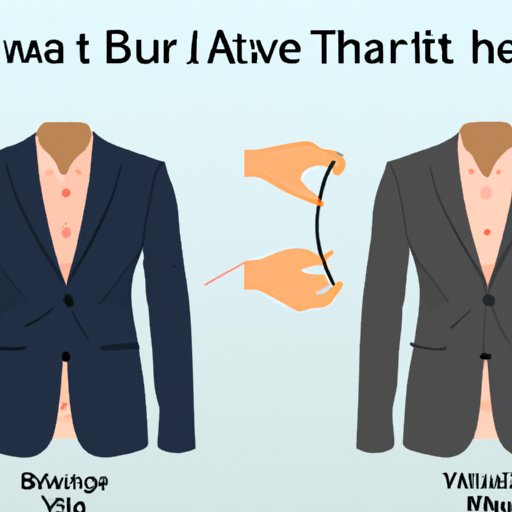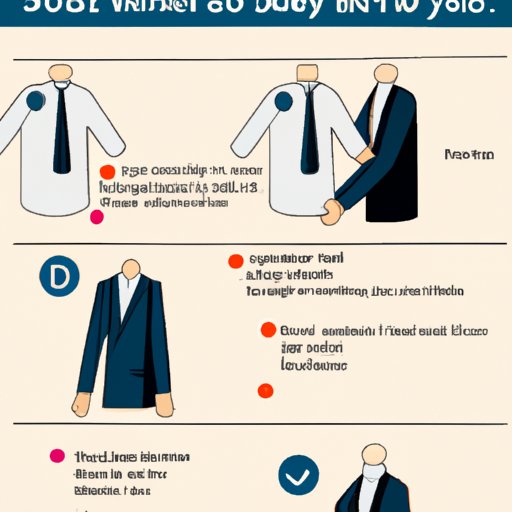Introduction
A blazer is a type of jacket that is typically made of solid-colored fabric with either metal buttons or plastic buttons. Blazers are usually worn in professional or semi-formal settings and can be paired with trousers or skirts. The key to looking great in a blazer is finding the right fit for your body type.
When it comes to blazers, there are three main types of fits: slim fit, regular fit, and relaxed fit. Slim fit blazers are cut closely to the body and feature minimal extra fabric, while regular fit blazers are tailored but not overly snug. Relaxed fit blazers have more fabric and a looser silhouette. Finding the right fit for your body type is essential for achieving the perfect look.
The Do’s and Don’ts of Wearing a Blazer
Do’s
When choosing a blazer, it is important to consider the following do’s:
1. Wear the right fit for your body type. Choosing the right fit for your body type is essential for achieving a polished and professional look. If you are petite, opt for a slim fit blazer to avoid an overly baggy look. Similarly, tall individuals should avoid overly snug blazers and instead opt for a regular or relaxed fit.
2. Consider the occasion when selecting a blazer. Blazers come in a variety of styles and fabrics, and it is important to choose one that is appropriate for the occasion. For example, if you are attending a formal event, opt for a traditional wool blazer with metal buttons. For a more casual look, try a linen blazer with plastic buttons.
3. Make sure the length is appropriate. The length of a blazer should hit at the hips, just above the belt line. If it is too long, it will look sloppy and unkempt. On the other hand, if it is too short, it will look too tight and uncomfortable.
Don’ts
In addition to the do’s, it is also important to consider the following don’ts:
1. Don’t wear an ill-fitting blazer. An ill-fitting blazer can make you look disheveled and frumpy. It is important to make sure the blazer fits properly and is comfortable to wear.
2. Don’t try to squeeze into a blazer that is too small. Trying to squeeze into a blazer that is too small is never a good idea. Not only will it be uncomfortable, but it will also look unflattering and could potentially ruin the blazer.
3. Don’t go for a baggy, oversized blazer. Baggy, oversized blazers can make you look sloppy and unprofessional. Stick to blazers that are tailored to your body type for the best look.

How to Find the Perfectly Fitting Blazer for Your Body Type
Finding the perfectly fitting blazer for your body type can seem daunting, but it doesn’t have to be. With the right measurements and a little bit of trial and error, you can find the perfect blazer for your body type.
Measurements
The first step in finding the perfect blazer for your body type is to take accurate measurements. This includes measuring your chest size, waist size, shoulder width, and sleeve length. Knowing these measurements will help you determine which size blazer to buy.
Try on multiple sizes
Once you have taken your measurements, it is time to try on different sizes. Keep in mind that sizes can vary from brand to brand, so it is important to try on multiple sizes and styles to ensure you find the right fit.
Compare online and in-store options
If you are shopping online, compare the measurements of the blazer to your own measurements to ensure you are getting the right fit. If you are shopping in-store, try on the blazer and move around to make sure it is comfortable and not too tight or too loose.

A Guide to Knowing When Your Blazer is Too Tight or Too Loose
Signs of a blazer being too tight
There are several signs that indicate a blazer is too tight:
1. Restriction of movement. If you feel restricted when you move, then the blazer is likely too tight. You should be able to move freely without feeling constricted.
2. Gaps between buttons. If there are gaps between the buttons when the blazer is buttoned up, then it is too tight. The buttons should fit snugly against the fabric.
3. Bulging fabric. If the fabric is bulging at the seams, then it is a sign that the blazer is too tight. The fabric should lay flat against your body.
Signs of a blazer being too loose
Here are some signs that indicate a blazer is too loose:
1. Shoulders slouching. If the shoulders of the blazer are slouching, then it is too loose. The shoulders should be fitted and sit squarely on your body.
2. Excess fabric in the arms. If the sleeves are too long or there is excess fabric in the arms, then the blazer is likely too loose. The sleeves should end at the wrist bone and the fabric should lay smoothly against your arm.
3. Sleeves bunching up. If the sleeves are bunching up at the elbows or wrists, then the blazer is too loose. The sleeves should hang straight and fit snugly against your arms.
Tips on How to Alter Your Blazer to Get the Right Fit
If you have found the perfect blazer but it isn’t quite the right fit, don’t worry! There are several ways to alter a blazer to get the perfect fit. Here are a few tips:
1. Taking in the sides. If the blazer is too big in the waist or hips, you can have it taken in at the sides to create a more fitted look.
2. Shortening the sleeves. If the sleeves are too long, you can have them shortened to the desired length.
3. Adding darts. If the blazer is too loose in the chest, you can have darts added to create a more tailored look.
4. Adjusting the shoulders. If the shoulders of the blazer are slouching or drooping, you can have them adjusted for a better fit.
Conclusion
Finding the perfectly fitting blazer for your body type is essential for achieving a polished, professional look. By taking accurate measurements, trying on multiple sizes, and comparing online and in-store options, you can find the perfect blazer for your body type. If the blazer is still not quite the right fit, you can always have it altered to get the perfect fit.
(Note: Is this article not meeting your expectations? Do you have knowledge or insights to share? Unlock new opportunities and expand your reach by joining our authors team. Click Registration to join us and share your expertise with our readers.)
